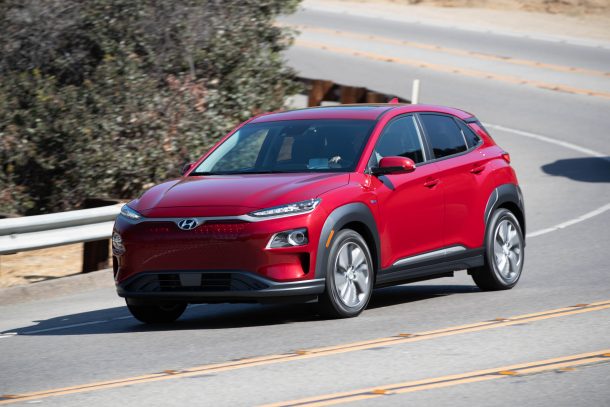2021 Hyundai EVs Get Fast Charging Free
Hyundai’s 2021 Kona Electric and Ioniq Electric now include 250 kWh of complimentary fast charging through Electrify America, with more than 2,400 ultra-fast chargers across the U.S. According to Electrify America, 96 percent of the population lives within a 120-mile radius of one of their chargers.
Whether it’s in response to concerns among potential buyers, or it’s an incentive to get more drivers to switch from internal combustion engines to electric vehicles, Hyundai is attempting to make ditching your gas-powered vehicle for one of their EVs a little easier.
To help clarify what Hyundai is offering, the EPA estimated driving range of both Hyundai EVs with 250 kWh of power is about 1,000 miles. There is the usual disclaimer about vehicle options, driving conditions and habits, your new vehicle’s condition, and that of its batteries, with anything not noted covered as other factors.
It takes about 54 minutes on a 100-kW DC fast charger or 75 minutes on a 50-kW DC fast charger to top off your Hyundai. Again, it varies depending on the battery level, the output of the charging unit, and the outside temperature. The 2021 Kona EV has a 258-mile, EPA-estimated range, based on a full charge. Fueleconomy.gov, the U.S. government’s official source, says the 2021 Kona with a 1.6-liter, 4-cylinder gas engine gets 30 MPG combined, 28 MPG city, and 32 highway, just as a point of reference.
The 2021 Ioniq Electric has a 170-mile, EPA-estimated range, also based on a full charge. The EPA uses an equivalent measure of gasoline fuel efficiency for EVs called MPGe, and the 2021 Ioniq EVs numbers are 133, combined, 145 city, and 121 highway MPGe. While we’re not inclined to trade in our gas-powered vehicles for an EV just yet, it is somewhat comforting knowing that in lieu of a gas card, Hyundai is prepared to give you a ‘charge’ card when buying a 2021 Kona or Ioniq EV.
[Images: Hyundai, Electrify America]
With a father who owned a dealership, I literally grew up in the business. After college, I worked for GM, Nissan and Mazda, writing articles for automotive enthusiast magazines as a side gig. I discovered you could make a living selling ad space at Four Wheeler magazine, before I moved on to selling TV for the National Hot Rod Association. After that, I started Roadhouse, a marketing, advertising and PR firm dedicated to the automotive, outdoor/apparel, and entertainment industries. Through the years, I continued writing, shooting, and editing. It keep things interesting.
More by Jason R. Sakurai
Latest Car Reviews
Read moreLatest Product Reviews
Read moreRecent Comments
- Mike Bradley Autonomous cars were developed in Silicon Valley. For new products there, the standard business plan is to put a barely-functioning product on the market right away and wait for the early-adopter customers to find the flaws. That's exactly what's happened. Detroit's plan is pretty much the opposite, but Detroit isn't developing this product. That's why dealers, for instance, haven't been trained in the cars.
- Dartman https://apnews.com/article/artificial-intelligence-fighter-jets-air-force-6a1100c96a73ca9b7f41cbd6a2753fdaAutonomous/Ai is here now. The question is implementation and acceptance.
- FreedMike If Dodge were smart - and I don't think they are - they'd spend their money refreshing and reworking the Durango (which I think is entering model year 3,221), versus going down the same "stuff 'em full of motor and give 'em cool new paint options" path. That's the approach they used with the Charger and Challenger, and both those models are dead. The Durango is still a strong product in a strong market; why not keep it fresher?
- Bill Wade I was driving a new Subaru a few weeks ago on I-10 near Tucson and it suddenly decided to slam on the brakes from a tumbleweed blowing across the highway. I just about had a heart attack while it nearly threw my mom through the windshield and dumped our grocery bags all over the place. It seems like a bad idea to me, the tech isn't ready.
- FreedMike I don't get the business case for these plug-in hybrid Jeep off roaders. They're a LOT more expensive (almost fourteen grand for the four-door Wrangler) and still get lousy MPG. They're certainly quick, but the last thing the Wrangler - one of the most obtuse-handling vehicles you can buy - needs is MOOOAAAARRRR POWER. In my neck of the woods, where off-road vehicles are big, the only 4Xe models I see of the wrangler wear fleet (rental) plates. What's the point? Wrangler sales have taken a massive plunge the last few years - why doesn't Jeep focus on affordability and value versus tech that only a very small part of its' buyer base would appreciate?






































Comments
Join the conversation
That statistic about Electrify America locations is a bad joke. 120 miles from a charger is uselessly far. Most trips are NOT cross-country.
1,000 miles is a Bugatti territory.